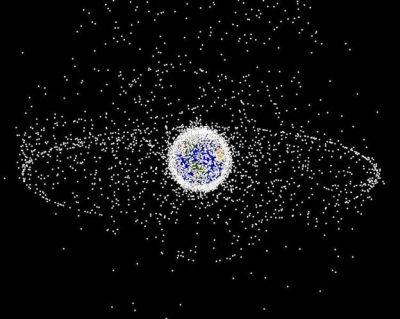15 February 2009

A NASA plot of space debris around Earth
Credit: NASA
On 10 February 2009, a US commercial communication satellite, called Iridium 33, collided with a defunct Russian Cosmos 2251 satellite. The collision occurred about 800 km, over northern Siberia. This is an unprecedented event and one of the most serious space accidents. The impact produced a large cloud of debris that may only pose a low threat to other spacecraft in Earth orbit, including the International Space Station (ISS), which orbits Earth at an altitude of about 340 km.
The satellites collided at a speed of over 40,000 km per hour. The military Cosmos 2251 satellite was launched in 1993, and ceased to operate two years later. Its mass was approximately 1,000 kg. The 560-kg Iridium 33 satellite was operational. It was launched in 1997.
American and Russian experts are tracking the fragments of the shattered satellites. About 6,000 satellites have been launched into space, since the launch of Sputnik 1, the first artificial satellite, in 1957.
About 50% of these satellites remain operational. Expended artificial objects in Earth orbit, including defunct satellites, rocket stages, paint flakes, and explosion debris, are termed space debris or space junk. It is estimated that there are about 17,000 pieces of space debris.
References
The BBC News Online
Wikipedia
NYTimes.com
Aymen Mohamed Ibrahem
Senior Astronomy Specialist